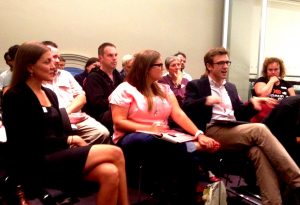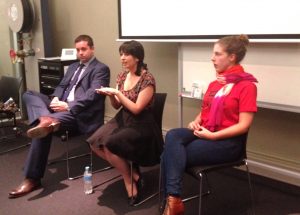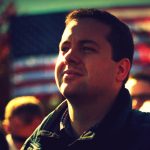 Learning from US election campaigning is like eating a meal in a US diner – you have to pick out the good bits from the parts you just can’t stomach.
Learning from US election campaigning is like eating a meal in a US diner – you have to pick out the good bits from the parts you just can’t stomach.
So, yes to effective field organising and no to a political system corrupted by colossal amounts of money. Yes to message discipline but a maybe to ethically blurry data collection.
Some of us opt for the super-sized meal while others settle for the chopped salad… so to speak.
This is part of what made our latest Melbourne Campaigners’ Network event so interesting. The US Election Report-back on Thursday 28 February attracted around 30 folks from a range of social movements to hear stories from three Melbourne campaigners who worked in the US during the election.
 In our discussion we grappled with the different approaches to politics and campaigning in the US and Australia, and how we can translate US innovations to our own context. We also had a valuable view from the other side, with a community organiser from New York in attendance.
In our discussion we grappled with the different approaches to politics and campaigning in the US and Australia, and how we can translate US innovations to our own context. We also had a valuable view from the other side, with a community organiser from New York in attendance.
Here’s some ‘take home messages’ from each of our presenters.
 Lucy Manne is Co-director of the Australian Youth Climate Coalition (AYCC). She worked as the New Media Director for the New Hampshire Democratic Congressional candidate, Annie Kuster, in a highly competitive race. Lucy was responsible for list growth, grassroots fundraising, social media, online volunteer recruitment and more on the campaign – which won!
Lucy Manne is Co-director of the Australian Youth Climate Coalition (AYCC). She worked as the New Media Director for the New Hampshire Democratic Congressional candidate, Annie Kuster, in a highly competitive race. Lucy was responsible for list growth, grassroots fundraising, social media, online volunteer recruitment and more on the campaign – which won!
Lucy’s key lessons from the Kuster campaign:
- Share knowledge and infrastructure. Different Democrat campaigns, as well as allied organisations, shared campaign intelligence, data, skills and resources. This meant that time and energy that would otherwise be spent ‘reinventing the wheel’ went directly into winning votes.
- Know your audiences. Be clear about who you need to communicate with and what they need to hear from you. Gather data to fill out the picture and ensure targeted communications.
- Keep integrated and updated data. Data was very important to the campaign with real-time updating and access to the data. Every campaign interaction was logged in the database to inform future communications.
- Build relationships online and offline. This was crucial to fundraising and building the volunteer base. The Kuster campaign did a good job of building a strong connection between the candidate, supporters and potential voters.
 Victoria McKenzie-McHarg is the Safe Climate Campaign Manager at Environment Victoria. Victoria spent three months working with the Sierra Club’s Beyond Coal campaign, focused on grassroots organising structures, movement cohesion and the role of health based communication in coal campaigns. Victoria gained an insider’s view into the relationship between political and NGO organising throughout the US election period.
Victoria McKenzie-McHarg is the Safe Climate Campaign Manager at Environment Victoria. Victoria spent three months working with the Sierra Club’s Beyond Coal campaign, focused on grassroots organising structures, movement cohesion and the role of health based communication in coal campaigns. Victoria gained an insider’s view into the relationship between political and NGO organising throughout the US election period.
Victoria’s observations and lessons:
- Short term election campaigning vs long term community organising. Election campaigns can be quite disempowering for volunteers as they have limited autonomy – they need to do specific tasks and stay on message. Community organising is about deeper relationships and developing power over time. If you want long term wins you need to build a committed culture of volunteering and organising. The Sierra Club has done that over decades.
- The centrality of personal relationships. Organising in the US involves very deliberate and positive networking. Sharing personal stories is integral to how they campaign. This builds trust between organisers and organisations.
- Cooperation between organisations. Victoria experienced a culture of sharing and generosity both from individual campaigners or organisers, and from organisations. Australian environment organisations struggle to work as successfully in alliances, and at times have been overwhelmed by ‘brand protection’ and competition.
Environment Victoria will be hosting another report-back from Victoria in March – details soon.
 Alex White is an advisor working in the labour movement who also blogs on communications, politics and campaigning. He spent 3 months working as an Organizing Fellow for Obama for America Massachusetts. Alex coordinated a team of volunteers, organised neighbourhood team training and managed a get-out-the-vote call-centre in the final week of the election.
Alex White is an advisor working in the labour movement who also blogs on communications, politics and campaigning. He spent 3 months working as an Organizing Fellow for Obama for America Massachusetts. Alex coordinated a team of volunteers, organised neighbourhood team training and managed a get-out-the-vote call-centre in the final week of the election.
Key insights from Alex:
- Goal focus. Nothing was done in the Obama for America (OFA) campaign unless it contributed to the goal of 270 (the number of electoral college votes needed to win). When campaign managers woke up each morning they checked how many phone calls had been made and how many doors knocked on.
- Message discipline. Messages were decided on and repeated consistently – Obama was still saying ‘Forward’ at his acceptance speech. This flowed on to all aspects of the campaign including field volunteers. For example in GOTV (get out to vote) conversations volunteers used a tested script including: “you seem like a voter”, “everyone’s doing it”, “lets make a plan” and then Commitment.
- Campaign structure. OFA used the ‘snowflake model‘ for neighbourhood teams, ‘a system in which members of the team have shared responsibility for a common goal but work independently toward achieving their own components.’ The model operated at a number of scales in the campaign. For example a neighbourhood team leader would coordinate a team including a phone bank coordinator and canvass coordinator; these coordinators would be in the centre of their own ‘snowflake’, coordinating a team; while neighbourhood team leaders were coordinated by regional team leaders, who were coordinated by state team leaders, each in their own ‘snowflake’ team.
Download Alex White’s slides from the night and see the Obama 2012 posts on his blog.
Many thanks to our clever and generous presenters, everyone who participated in the discussion, all the helpers, and Gareth Beyers for excellent live-tweeting.
For more on this topic see also Lessons from the US Election.
Our next Melbourne Campaigners’ Network event is on Nonviolent Direct Action, 6pm-8pm, Thursday 11 April at the Wheeler Centre.
What were your ‘take-aways’ from the night? What questions remain? What about suggestions for future sessions? Chime in below.
